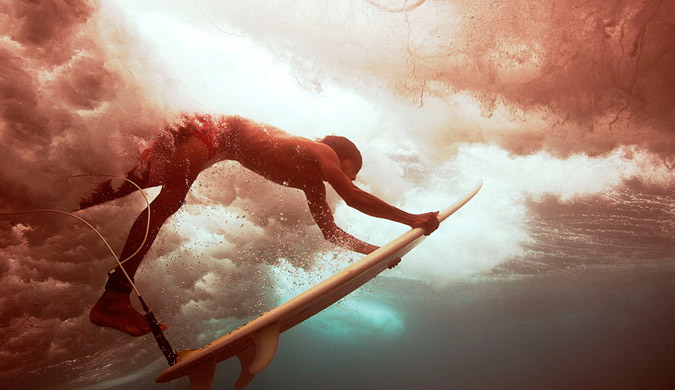
Get under it quicker and faster. Photo: Obdulio Luna
Getting caught inside sucks. Whether you are just learning to surf, or have been doing it for years, you will no doubt know this feeling. By the third or fourth duck dive, you have been thrown about enough to be pretty out of breath, your arms feel like jelly, and if you are just new to surfing, you can get a little panicked.
In surfing there is one universal truth that is good to keep in mind: YOU CAN’T OUT-TOUGH THE OCEAN. You can only learn how to roll with it.
Start by watching this video:
Breaking the duck dive into its component parts
Upper body:
Arms – open chain pushing. Yep, open chain. This means that when you push against something, like when you press into your board, it moves away from you. Push ups are great and all, but bench press is better.
The bench press isn’t just for bodybuilders, folks. There are ways of doing the bench press so that you can train your shoulder stabilizers in a functionally integrative way. A swiss ball can be perfect for this, as the rest of your body is still having to stabilize you on the ball, and your shoulder blades are still free to move. Lying on a bench doesn’t give you this same feeling, and it sometimes fixes your shoulder blades together. That is bad news for your anterior shoulder capsule.
Lower body:
Don’t try and do it all with your arms, let your legs do the work as well. This means getting your opposite leg in the air as you are pressing the board under. Think of lifting your leg from your butt. That leg will help you sink the board, while the other then drives through the tail pad to get your board under the wave.
This means we need to work on some single leg hip stability, and leg pressing exercises. In the video above, I take you through box step ups and prone jackknife modifications so that you can start training for this on dry land.

The single legged prone jackknife is an advanced exercise for hip and shoulder stability, but is perfect to build up to!
What about sets and reps?
Strength endurance:
Always start with strength endurance as a safe way of training, especially if you haven’t done much fitness work. This means working into repetition zones of 12-15, or a time under tension of 60 secs and beyond for each exercise.
For example, if you were doing a box step up, you would perform all 12-15 reps on the one leg, before switching to the other, which would take you 60 secs+ to perform.
Functional strength:
Once you have this sorted, then think about strength training. It usually involves heavier weights, or more complicated stability based movements. Strength training is progressed for duck diving into 6-8 rep loading zones, or 20-30 seconds of time under tension.
Don’t go straight into strength training if your body isn’t used to it, or you may need my corrective programs to get you back to health.
You still have to practice in the water!
Duck diving is a skill, that takes practice, timing, and persistence to get right. If you are new to surfing, or just land-locked, then getting fit is a great place to start, but you also need to practice in the water. You may get it wrong more times than you get it right to begin with, but it’s a learning process.
When it comes to putting this skill into practice, my most important piece of advice is this: commit to it. Even if you suck. If you paddle for a wave thinking you aren’t going to catch it, you probably won’t. You will hesitate, and that’s when bad shit happens.
The same goes for duck diving: paddle into it and commit to it. The better your duck dive, and the faster you can start paddling out the other side, and the less duck dives you need to do. The more you hesitate, the more you get thrown or pushed backward, and the more duck dives you have ahead of you to get out the back.
If you have questions on anything to do with nutrition, or surf fitness that you would like to see answered here, just drop me an email at ash@weekendsurfwarrior.com.
See more health tips from Ash at Weekendsurfwarrior.com

